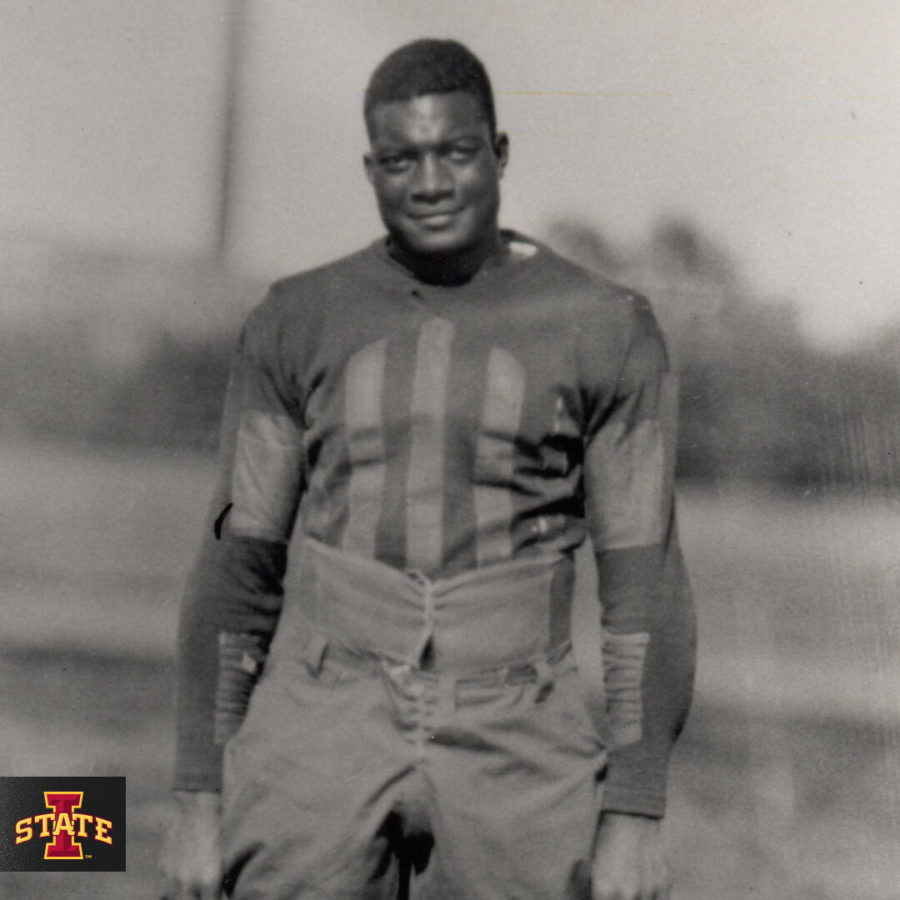Jack Trice’s legacy continues to fight for racial justice
A picture of Jack Trice in 1923. Trice’s uniform pattern was honored by Iowa State Athletics with the addition of a new uniform patch for the 2020 season.
September 14, 2021
Sept. 7, Iowa State’s equipment operations released a picture of their new set of apparel that prominently features the Jack Trice symbol. While it was not made available to the public, interest and enthusiasm for the symbol have grown massively in recent years.
“I love how it’s [the logo] been used so far,” said Noah Mack, a sophomore in computer engineering. “It looks incredible overlooking the field […] It looks good on the jerseys of the players. It’s a very clean logo.”
The symbol has gained a lot of celebrity recently; however, its history is incredibly storied. The symbol represents the jersey design worn by Jack Trice, who gave his life to honor both his race and university.
According to Dorothy Schwieder from the State Historical Society of Iowa, Jack Trice was the first African-American athlete at Iowa State to compete in a varsity sport, entering the 1923 football season as a defensive lineman. He broke through a tremendous barrier, and through hard work and dedication, he earned the respect of his teammates and his fellow students.
Before Iowa State’s game against the University of Minnesota, Jack Trice wrote a letter that would go on to inspire generations of students. According to Schwieder, Jack Trice wrote, “The honor of my race, family and self are at stake. Everyone is expecting me to do big things. I will…”
According to Cyclone TV, during the game, Trice suffered injuries which he was unable to recover from. He suffered from a broken collarbone and later passed away due to internal bleeding as a result of being stepped on by several Minnesota players. Despite his injuries, he was determined to stay on the field alongside his team.
The tale of Jack Trice has become ingrained in school culture, and his bravery and determination continue to influence all of Iowa State. This influence has been particularly noticeable in the athletic department, as Trice stands as the prominent figure who players and coaches desire to emulate. To represent his legacy, the university designed a logo composed of five vertical lines based on his 1923 jersey design. The symbol brings awareness to a story that is fundamental to Iowa State’s history and culture.
Awareness of his story began in 1997 when Iowa State renamed the football stadium after Jack Trice, following years of student and faculty petition for the name change, as stated in an article from The Undefeated.
Campus-wide awareness was spread even more in 2013 when Iowa State took great strides to honor the legacy of Jack Trice. The football team debuted a throwback jersey featuring the stripes, and the entrance tunnel to the field was redone, prominently displaying a picture of Jack Trice along with his own words.
Over the past few years, the symbol has become a main focus of the program. The symbol has spread across the athletic department as a means of making the story of Jack Trice known. Following a summer of racial injustice and social unrest in 2020, the athletic department took the opportunity to make the symbol and story of Jack Trice even more prominent. For the 2020 season, the football team included a Jack Trice patch on their jerseys.
According to Iowa State, the football program supports equality and stands against all forms of racism and discrimination in our society. The symbol has been used not only to represent the great story of Jack Trice but also the importance of equality and racial justice.
“I definitely think it helps get more people to know the story and appreciate the history behind [Jack Trice],” Mia Abeja, a sophomore in psychology, said.
Since 2020, the symbol has been everywhere, from t-shirts to cups and flags. For the 2021 football poster, the symbol is prominently featured, further extending the message and symbolism. Even the marching band formed the words, “I Will,” during their performance Sept. 11. Despite this, according to students, the university can still do more to ensure that every student knows the sacrifice Jack Trice made.
“I feel like they should spread [his story] more… If everybody knew the story and there was more widespread knowledge about it,” said Abeja. “It would definitely help spread inclusivity.”







